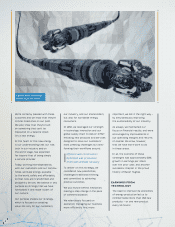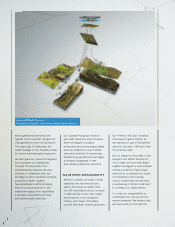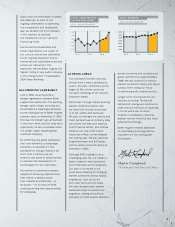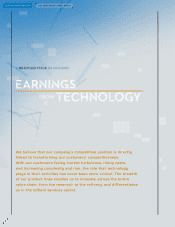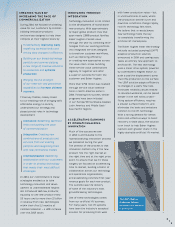Baker Hughes 2014 Annual Report Download - page 16
Download and view the complete annual report
Please find page 16 of the 2014 Baker Hughes annual report below. You can navigate through the pages in the report by either clicking on the pages listed below, or by using the keyword search tool below to find specific information within the annual report.
STANDARDIZINGTO
STREAMLINEOPERATIONS
ANDCREATEVALUE
Our customers are committed to
reducing capital expenditures across
their operations, and one avenue
they are taking is standardization.
We believe that standardization
is a true differentiator in the
marketplace, and our focus on it
throughout 2014 resulted in some
remarkable outcomes related to
lower manufacturing costs, reduced
lead times, less inventory,
and improved product quality.
In Europe, an initiative to stan-
dardize completion designs reduced
the number of required line
items from 137 to 21 standard parts,
diminished the number of different
control valve configurations
from 20 to three, and decreased
the number of different packer
configurations from 80 to seven.
All of these reductions simplified
on-time delivery, lessened wellsite
deployment risks, and enabled
us to create shareholder value
through closer, more influencing
roles with our customers.
The Drilling Services business
initiated a standardized drilling
platform to satisfy customer
requirements for cost-effective
and efficient resource recovery in
higher-density, hotter, deeper,
and extended-lateral downhole
environments. The optimized archi-
tecture, based on hybrid integrated
circuits from our new plant in
Celle, Germany, will provide more
data, more rapidly, from sensors
that are closer to the bit,
while providing improved reliability
and efficiency of asset utilization.
To streamline supply chain activities
surrounding its 600,000 unique
combinations of metallurgy,
elastomers, threads, and product
models, the completions and
wellbore intervention business
launched an initiative aimed
at improving how we market, sell,
manufacture, distribute, and deliver
completion products. The program
segmented the completions
sales portfolio into four natural
supply chains, which freed up
capacity at our highly specialized
manufacturing facilities to focus on
long-lead, customized orders. It also
reduced inventory levels and the
total number of tools offered, drove
down costs, and ensured timely
delivery of products.
EXPANDINGINTONEW
MARKETSTHROUGH
ACQUISITIONSALLIANCES
ANDALTERNATIVEBUSINESS
MODELS
During the year, Baker Hughes
expanded into new markets
through a combination of acquisi-
tions, alliances, and alternative
business models.
We augmented our midstream
presence with the September acqui-
sition of the pipeline and specialty
service business of Weatherford
International plc, giving us
an expanded range of pre-commis-
sioning, deepwater, and in-line
inspection services worldwide.
Our strategic alliance with Aker
Solutions anticipates and prepares
for the next phase of innovation
in deep water, as this segment
moves toward the production era.
Through this alliance, we are able
to innovate a new range of
integrated solutions for subsea,
focusing initially on production and
intervention. The alliance is now
fully operational, and has started
to develop technologies to address
customer opportunities, enabling
increased production and recovery,
as well as reduced costs in both
greenfield and brownfield prospects.
The application of business
models typically characterized by
a risk/reward structure and a
longer-term customer commitment
enabled success in a major field
management project. In Malaysia,
our reservoir team determined
that redevelopment and enhanced
recovery are indeed economically
feasible in PETRONAS Carigali’s
greater D18 field.
Process and Pipeline.
Adding competitive new capabilities to
differentiate in midstream.


